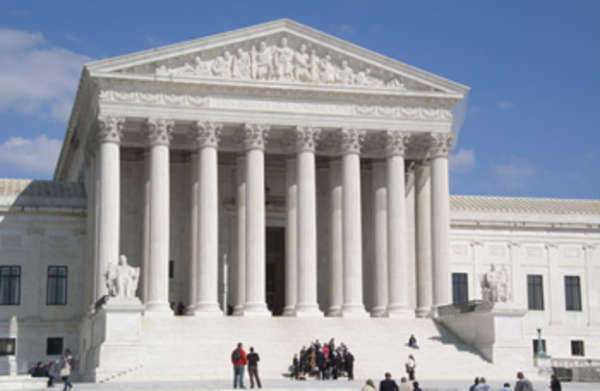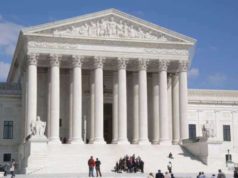Table of Contents
- 1 Chief Justice John Roberts
- 2 Associate Justice Clarence Thomas
- 3 Associate Justice Stephen Breyer
- 4 Associate Justice Samuel Alito
- 5 Associate Justice Sonia Sotomayor
- 6 Associate Justice Elena Kagan
- 7 Associate Justice Neil Gorsuch
- 8 Associate Justice Brett Kavanaugh
- 9 Associate Justice Amy Coney Barrett
- 10 Conclusion
- 11 Background of Justices
- 12 John Jay
- 13 John Marshall
- 14 Roger Taney
- 15 William Taft

The Supreme Court of the United States is the highest court in the country, consisting of nine justices appointed by the President. The Court’s primary function is to interpret the Constitution and federal law. They hear cases that have been appealed from lower courts and have the power to strike down laws that they believe are unconstitutional. Justices also play a crucial role in shaping American law through their legal opinions, which serves as precedent for future cases and can influence national policy on important issues.
The current members of the Supreme Court are Chief Justice John Roberts, and Associate Justices Clarence Thomas, Stephen Breyer, Samuel Alito, Sonia Sotomayor, Elena Kagan, Neil Gorsuch, Brett Kavanaugh, and Amy Coney Barrett. Each justice brings a unique perspective and background to the court, which can shape their legal opinions and influence the Court’s decisions.
Chief Justice John Roberts
John Roberts was born in Buffalo, New York, in 1955. He has been serving as the Chief Justice of the Supreme Court since 2005. Before his appointment to the Court, he served as a judge on the United States Court of Appeals for the District of Columbia Circuit. Roberts is widely considered to be a conservative on the Supreme Court. Despite this, he has been known to surprise observers with his expansive views of executive power and occasional swing votes. He has consistently voted against affirmative action and been sympathetic to business interests in cases concerning regulation and the environment. Additionally, Roberts has a strong interest in the stability of the law, its development over time, and has emphasized the importance of judicial independence and the rule of law.
Associate Justice Clarence Thomas
Clarence Thomas was born in Georgia in 1948, and in 1991 he was appointed to the Supreme Court by President George H.W. Bush. Thomas is known for his conservative views on the Supreme Court. He is an originalist who believes that the Constitution should be interpreted based on its original meaning. He has been highly critical of Roe v. Wade, the landmark decision that legalized abortion nationwide. Additionally, Thomas is known for his opposition to affirmative action and his skepticism of federal power. He takes a narrow view of the Commerce Clause, which gives Congress power to regulate commerce among the states.
Associate Justice Stephen Breyer
Stephen Breyer was born in San Francisco, California, in 1938. He was appointed to the Supreme Court by President Bill Clinton in 1994. Breyer is generally considered a pragmatic liberal on the Supreme Court. He is known for his emphasis on the practical consequences of legal rulings, which he uses to guide his decision making, and he often takes a more flexible approach to legal interpretation than some of his more ideologically rigid colleagues. Breyer is a strong advocate for individual rights and civil liberties, and he has been a vocal defender of the rights of criminal defendants. He is also an advocate for international law and often cites foreign legal precedents in his opinions.
Associate Justice Samuel Alito
Samuel Alito was born in New Jersey in 1950 and was appointed to the Supreme Court by President George W. Bush in 2006. Alito is generally considered a conservative on the Supreme Court. He is known for his strong interest in issues of federalism and the separation of powers, and he has been a consistent vote against affirmative action and other forms of race-based policies. Alito is also a strong advocate for individual rights, and he has written several influential opinions on the First Amendment and other civil liberties issues. He has also shown concern for the effects of technology on society and has been vocal on the Supreme Court’s stance in this regard.
Associate Justice Sonia Sotomayor
Sonia Sotomayor was born in New York City in 1954. She was appointed to the Supreme Court by President Barack Obama in 2009. Sotomayor is generally considered a liberal on the Supreme Court, and she is known for her strong interest in issues of social justice and her advocacy for the rights of minority groups and marginalized communities. Sotomayor has been a consistent vote in favor of affirmative action and other race-conscious policies, and she has also been a vocal defender of the rights of criminal defendants. Additionally, she has shown concern regarding areas such as voting rights and racial justice, and her opinions have been highly influential in those areas.
Associate Justice Elena Kagan
Elena Kagan was born in New York City in 1960. She was appointed to the Supreme Court by President Barack Obama in 2010. Kagan is generally considered a liberal on the Supreme Court. She is known for her strong academic background and her interest in legal theory and philosophy. Kagan is also an advocate for the rights of women and other marginalized groups, and she has written several influential opinions on issues such as the First Amendment and campaign finance reform. Additionally, she has demonstrated a strong understanding of administrative law, which has been a significant area of concern in several Supreme Court decisions in recent years.
Associate Justice Neil Gorsuch
Neil Gorsuch was born in Colorado in 1967. He was appointed to the Supreme Court by President Donald Trump in 2017. Gorsuch is generally considered a conservative on the Supreme Court. He is known for his strong interest in issues of federalism and the separation of powers, and he has been a consistent vote against federal agency action and executive authority. Gorsuch is also an originalist who believes in a strict interpretation of the Constitution, and he has been a critic of the Supreme Court’s expansive interpretation of individual rights and other constitutional doctrines. Additionally, he has been vocal in recent years regarding important national issues such as gun rights and national security.
Associate Justice Brett Kavanaugh
Brett Kavanaugh was born in Washington D.C., in 1965. He was nominated and confirmed to the Supreme Court by President Donald Trump in 2018. Kavanaugh is a conservative on the Supreme Court and has advocated for judicial restraint and statutory interpretation. He has been a critic of judicial activism and has often argued for originalism and textualism in his opinions. Kavanaugh has also been a strong advocate for the Second Amendment and has shown skepticism towards deference to federal agencies, going as far as to argue that the Court should limit such deference in his opinions.
Associate Justice Amy Coney Barrett
Amy Coney Barrett was appointed to the Supreme Court in 2020 by President Donald Trump. She was born in 1972 in Indiana and has been serving as a judge on the U.S. Court of Appeals for the Seventh Circuit since 2017. Barrett is generally considered a conservative on the Supreme Court. Her legal opinions reflect originalist ideology, and she has consistently advocated for a narrow interpretation of federal power. Barrett has also been a strong advocate for religious freedom and has expressed a desire to protect religious liberties from government interference. Additionally, she has been skeptical of the stare decisis principle, which holds that courts should follow their previous rulings in cases.
Conclusion
The Supreme Court justices play a pivotal role in shaping American law and society. The justices’ legal philosophies and backgrounds can range widely, which can influence their legal opinions and shape the decisions of the Court. This can have far-reaching consequences for American society, as demonstrated by landmark cases such as Brown v. Board of Education and Roe v. Wade. Therefore, it is crucial that policymakers continue to scrutinize the Court’s composition and the ideological leanings of its justices, as this can have a significant impact on the nation’s legal landscape and political trajectory.
Background of Justices
The Constitution’s provisions for the Justices who make up the Supreme Court are brief and have allowed extensive discretion to legislators and the Court itself in determining the direction of this office. The initial stipulations for the practical questions of operation faced by Supreme Court Justices were dealt with in the Judiciary Act of 1789, the first Congressional legislation.
The Justices first assembled to officially hold the Supreme Court in February 1790, at that point numbering six members and tasked with the secondary responsibility of “circuit riding,” by which they were required to personally preside over two proceedings at courts in every judicial district each year.
The role taken by Supreme Court Justices was fairly limited for the first decade of the institution’s existence but began to expand with the appointment of Chief Justice John Marshall, who established the principle of judicial review in the 1803 case of Marbury v. Madison. His term lasted until his death in 1834, in all comprising thirty-four years, and helped establish the principle of lifetime terms for Supreme Court Justices. The number of Justices, after several revisions, was fixed at nine in 1869, and the practice of circuit-riding abolished in 1891.
John Jay
John Jay was the first Chief Justice of the United States Supreme Court, appointed in 1789 by President Washington. His reign as Chief Justice helped build the foundation of practices, which helped the Supreme Court Justice system gain recognition as a reputable judicial branch. The time John Jay served as Chief Justice was mostly dedicated to implementing guidelines and regulations for the Court system to follow.
Stemming from his childhood John Jay had always expressed keen interest in governmental politics and he catered to a number of problems that presented itself as a result of war as well as weak practice measures. His time spent as Chief Justice initiated many Federal regulations that provided the strength that Supreme Justice is associated with today.
The great advisement John Jay delegated as Chief Justice led to his re-election of the role in 1795, which he declined. He continued to serve the United States as a political influence to the practices of the Government system until he retired in 1801.
John Marshall
John Marshall was appointed as the fourth Chief Justice of the Supreme Court and is documented as the first Chief Justice to hold the longest term in office. John Marshall’s views were a direct reflection of the regulations administered in the Constitution. His time spent as Chief Justice enforced all Federal and State laws established to be an extension of what was declared in the Constitution, as well as enforcing the judicial implements of John Jay.
With the Constitution at the time being a new form of conduct, many states and Federal laws offered their own translation of the Constitutional view. John Marshall helped clarify the direction of laws in relation to the Constitution. Many of the rulings made by John Marshall helped streamline the responsibilities and functions within the legislative branches. During his ruling as Chief Justice, many other members did not agree with his views on regulating State and Federal practices. However, the beliefs of John Marshall helped strengthen the value of the Supreme Court.
Roger Taney
The fact of Roger B. Taney holding the role of Supreme Chief Justice in 1836 dates back to the controversy accompanied by his position in the office during that time. Although the responsibility of Chief Justice at a Supreme Court level is to regulate Federal laws, Roger Taney can be described as the individual most concerned with the powers of the State Government.
Many of the cases Roger Tangey ruled against were during a time where a split preference over slavery existed among many individuals. While members were calling for the abolishment of slavery, Roger Taney was enforcing this act as a Constitutional right, and ruling against African Americans presented little regard for them as a race. At one point the judgemental view of Taney leads a member of the Supreme Court to resign.
The goal of Roger Taney was to make the abolishment of slavery unconstitutional, which was prevented due to the rise of the Civil War. Roger Taney held his position as Chief Justice until passing away shortly after slavery was abolished.
William Taft
William Taft was the first Supreme court Justice who also assumed the role as President of the United States. Many contributed to the structure of the Federal and State Government practices to the procedures implemented by Taft under his ruling as Supreme Court Justice. Seeing that the court system was very disorganized, Taft created certain Acts to help the process within the Supreme Court run at a smoother pace. His delegation helped the Supreme Court identify important cases while shifting other cases to the appropriate judicial branch.
William Taft spent a good deal of his time traveling and was fascinated by the methods of structure he saw implemented in other countries. His work as Supreme Court Chief Justice helped strengthen all judicial systems within America. He is also responsible for separating the Supreme Court from other judicial branches, placing it in a separate building where they could manage the aspects of their responsibilities away from the traffic associate with other legislative branches.



















